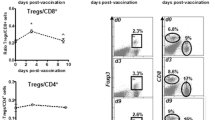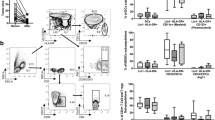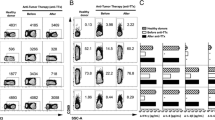Abstract
As pre-existent immunity might be a reflection of an emerging anticancer response, the demonstration of spontaneous T-cell responses against tumor associated antigens (TAAs) in cancer patients may be beneficial before clinical development of dendritic cell (DC)-based cancer vaccines, because it will help to identify likely responders to TAAs among patients who qualify and may benefit from this form of immune therapy. This study aimed to determine pre-existent T-cell reactivity against the tumor suppressor protein p53 in breast cancer patients (BCP) at the time point of primary diagnosis. After a short-term stimulation with autologous wt p53 mRNA-transfected DCs, IFN-γ enzyme-linked immunosorbent spot (ELISPOT) analysis revealed p53-reactive T cells in the peripheral blood of more than 40% (15 of 36) of the tested patients. Both CD4+ and CD8+ p53-specific T cells secreted IFN-γ after stimulation with p53-transfected DCs. Interestingly, more than 72% (13 of 18) of patients with high p53 (p53high) expression in tumors were able to mount a p53-specific IFN-γ T-cell response, in contrast to only 10% (1 of 10) of healthy donors and 11% (2 of 18) of patients with low or absent p53 (p53low) expression in tumors. Furthermore, significantly higher secretion of IL-2 was detected in peripheral blood mononuclear cells after stimulation with p53-transfected DCs from patients with p53high tumor expression compared to patients with p53low tumor expression, whereas secretion of IL-10 was predominant in the latter group. The high frequency of spontaneous wt p53-reactive T cells detected in the peripheral blood of primary BCP with accumulation of p53 in tumor provides a rationale to consider DCs transfected with mRNA encoding wt p53 for clinical investigation in these patients.




Similar content being viewed by others
Abbreviations
- DCs:
-
Dendritic cells
- TAAs:
-
Tumor associated antigens
- PBMCs:
-
Peripheral blood mononuclear cells
- MFI:
-
Mean fluorescence intensity
- ELISPOT:
-
Enzyme-linked immunosorbent spot
- BCP:
-
Breast cancer patients
- HD:
-
Healthy donors
- Abs:
-
Antibodies
References
Dunn GP, Bruce AT, Ikeda H, Old LJ, Schreiber RD (2002) Cancer immunoediting: from immunosurveillance to tumor escape. Nat Immunol 3:991–998
van der Bruggen P, Zhang Y, Chaux P et al (2002) Tumor-specific shared antigenic peptides recognized by human T cells. Immunol Rev 188:51–64
Tacken PJ, de Vries IJ, Torensma R, Figdor CG (2007) Dendritic-cell immunotherapy: from ex vivo loading to in vivo targeting. Nat Rev Immunol 7:790–802
Van Tendeloo VF, Ponsaerts P, Berneman ZN (2007) mRNA-based gene transfer as a tool for gene and cell therapy. Curr Opin Mol Ther 9:423–431
Van Tendeloo VF, Ponsaerts P, Lardon F et al (2001) Highly efficient gene delivery by mRNA electroporation in human hematopoietic cells: superiority to lipofection and passive pulsing of mRNA and to electroporation of plasmid cDNA for tumor antigen loading of dendritic cells. Blood 98:49–56
Kessler JH, Melief CJ (2007) Identification of T-cell epitopes for cancer immunotherapy. Leukemia 21:1859–1874
Theobald M, Biggs J, Dittmer D, Levine AJ, Sherman LA (1995) Targeting p53 as a general tumor antigen. Proc Natl Acad Sci USA 92:11993–11997
DeLeo AB, Whiteside TL (2008) Development of multi-epitope vaccines targeting wild-type sequence p53 peptides. Expert Rev Vaccines 7:1031–1040
Disis ML, Knutson KL, Schiffman K, Rinn K, McNeel DG (2000) Pre-existent immunity to the HER-2/neu oncogenic protein in patients with HER-2/neu overexpressing breast and ovarian cancer. Breast Cancer Res Treat 62:245–252
Nagorsen D, Scheibenbogen C, Schaller G et al (2003) Differences in T-cell immunity toward tumor-associated antigens in colorectal cancer and breast cancer patients. Int J Cancer 105:221–225
Rentzsch C, Kayser S, Stumm S et al (2003) Evaluation of pre-existent immunity in patients with primary breast cancer: molecular and cellular assays to quantify antigen-specific T lymphocytes in peripheral blood mononuclear cells. Clin Cancer Res 9:4376–4386
Met O, Eriksen J, Svane IM (2008) Studies on mRNA electroporation of immature and mature dendritic cells: effects on their immunogenic potential. Mol Biotechnol 40:151–160
Pedersen AE, Thorn M, Gad M et al (2005) Phenotypic and functional characterization of clinical grade dendritic cells generated from patients with advanced breast cancer for therapeutic vaccination. Scand J Immunol 61:147–156
Garcia-Tunon I, Ricote M, Ruiz A et al (2006) Cell cycle control related proteins (p53, p21, and Rb) and transforming growth factor beta (TGFbeta) in benign and carcinomatous (in situ and infiltrating) human breast: implications in malignant transformations. Cancer Invest 24:119–125
McCutcheon M, Wehner N, Wensky A et al (1997) A sensitive ELISPOT assay to detect low-frequency human T lymphocytes. J Immunol Methods 210:149–166
Svane IM, Pedersen AE, Johansen JS et al (2007) Vaccination with p53 peptide-pulsed dendritic cells is associated with disease stabilization in patients with p53 expressing advanced breast cancer; monitoring of serum YKL-40 and IL-6 as response biomarkers. Cancer Immunol Immunother 56:1485–1499
Goodell V, Salazar LG, Urban N et al (2006) Antibody immunity to the p53 oncogenic protein is a prognostic indicator in ovarian cancer. J Clin Oncol 24:762–768
Valmori D, Scheibenbogen C, Dutoit V et al (2002) Circulating Tumor-reactive CD8(+) T cells in melanoma patients contain a CD45RA(+)CCR7(−) effector subset exerting ex vivo tumor-specific cytolytic activity. Cancer Res 62:1743–1750
Karanikas V, Colau D, Baurain JF et al (2001) High frequency of cytolytic T lymphocytes directed against a tumor-specific mutated antigen detectable with HLA tetramers in the blood of a lung carcinoma patient with long survival. Cancer Res 61:3718–3724
Hoffmann TK, Donnenberg AD, Finkelstein SD et al (2002) Frequencies of tetramer + T cells specific for the wild-type sequence p53(264–272) peptide in the circulation of patients with head and neck cancer. Cancer Res 62:3521–3529
Chikamatsu K, Sakakura K, Takahashi G et al (2009) CD4+ T cell responses to HLA-DP5-restricted wild-type sequence p53 peptides in patients with head and neck cancer. Cancer Immunol Immunother 58:1441–1448
van der Burg SH, de Cock K, Menon AG et al (2001) Long lasting p53-specific T cell memory responses in the absence of anti-p53 antibodies in patients with resected primary colorectal cancer. Eur J Immunol 31:146–155
Sotiropoulou PA, Perez SA, Voelter V et al (2003) Natural CD8+ T-cell responses against MHC class I epitopes of the HER-2/neu oncoprotein in patients with epithelial tumors. Cancer Immunol Immunother 52:771–779
Lewis JD, Reilly BD, Bright RK (2003) Tumor-associated antigens: from discovery to immunity. Int Rev Immunol 22:81–112
Gnjatic S, Cai Z, Viguier M et al (1998) Accumulation of the p53 protein allows recognition by human CTL of a wild-type p53 epitope presented by breast carcinomas and melanomas. J Immunol 160:328–333
Vierboom MP, Zwaveling S, Bos GMJ et al (2000) High steady-state levels of p53 are not a prerequisite for tumor eradication by wild-type p53-specific cytotoxic T lymphocytes. Cancer Res 60:5508–5513
Inokuma M, dela Rosa C, Schmitt C et al (2007) Functional T cell responses to tumor antigens in breast cancer patients have a distinct phenotype and cytokine signature. J Immunol 179:2627–2633
Sommerfeldt N, Schutz F, Sohn C et al (2006) The shaping of a polyvalent and highly individual T-cell repertoire in the bone marrow of breast cancer patients. Cancer Res 66:8258–8265
Nishikawa H, Kato T, Tanida K et al (2003) CD4+ CD25+ T cells responding to serologically defined autoantigens suppress antitumor immune responses. Proc Natl Acad Sci USA 100:10902–10906
Okada K, Komuta K, Hashimoto S et al (2000) Frequency of apoptosis of tumor-infiltrating lymphocytes induced by fas counterattack in human colorectal carcinoma and its correlation with prognosis. Clin Cancer Res 6:3560–3564
Kurnick JT, Ramirez-Montagut T, Boyle LA et al (2001) A novel autocrine pathway of tumor escape from immune recognition: melanoma cell lines produce a soluble protein that diminishes expression of the gene encoding the melanocyte lineage melan-A/MART-1 antigen through down-modulation of its promoter. J Immunol 167:1204–1211
Nikitina EY, Clark JI, Van Beynen J et al (2001) Dendritic cells transduced with full-length wild-type p53 generate antitumor cytotoxic T lymphocytes from peripheral blood of cancer patients. Clin Cancer Res 7:127–135
Humrich J, Jenne L (2003) Viral vectors for dendritic cell-based immunotherapy. Curr Top Microbiol Immunol 276:241–259
Reuschenbach M, von Knebel DM, Wentzensen N (2009) A systematic review of humoral immune responses against tumor antigens. Cancer Immunol Immunother 8:1535–1544
Vujanovic L, Ranieri E, Gambotto A et al (2006) IL-12p70 and IL-18 gene-modified dendritic cells loaded with tumor antigen-derived peptides or recombinant protein effectively stimulate specific Type-1 CD4+ T-cell responses from normal donors and melanoma patients in vitro. Cancer Gene Ther 13:798–805
Minkis K, Kavanagh DG, Alter G et al (2008) Type 2 Bias of T cells expanded from the blood of melanoma patients switched to type 1 by IL-12p70 mRNA-transfected dendritic cells. Cancer Res 68:9441–9450
Hung K, Hayashi R, Lafond-Walker A et al (1998) The central role of CD4(+) T cells in the antitumor immune response. J Exp Med 188:2357–2368
Pardoll DM, Topalian SL (1998) The role of CD4+ T cell responses in antitumor immunity. Curr Opin Immunol 10:588–594
Gilboa E, Vieweg J (2004) Cancer immunotherapy with mRNA-transfected dendritic cells. Immunol Rev 199:251–263
Muller MR, Grunebach F, Nencioni A, Brossart P (2003) Transfection of dendritic cells with RNA induces CD4- and CD8-mediated T cell immunity against breast carcinomas and reveals the immunodominance of presented T cell epitopes. J Immunol 170:5892–5896
Kyte JA, Kvalheim G, Aamdal S, Saeboe-Larssen S, Gaudernack G (2005) Preclinical full-scale evaluation of dendritic cells transfected with autologous tumor-mRNA for melanoma vaccination. Cancer Gene Ther 12:579–591
Nimmerjahn F, Milosevic S, Behrends U et al (2003) Major histocompatibility complex class II-restricted presentation of a cytosolic antigen by autophagy. Eur J Immunol 33:1250–1259
Kalady MF, Onaitis MW, Padilla KM et al (2002) Enhanced dendritic cell antigen presentation in RNA-based immunotherapy. J Surg Res 105:17–24
Nair SK, Boczkowski D, Morse M et al (1998) Induction of primary carcinoembryonic antigen (CEA)-specific cytotoxic T lymphocytes in vitro using human dendritic cells transfected with RNA. Nat Biotechnol 16:364–369
Schaft N, Dorrie J, Thumann P et al (2005) Generation of an optimized polyvalent monocyte-derived dendritic cell vaccine by transfecting defined RNAs after rather than before maturation. J Immunol 174:3087–3097
Javorovic M, Pohla H, Frankenberger B, Wolfel T, Schendel DJ (2005) RNA transfer by electroporation into mature dendritic cells leading to reactivation of effector-memory cytotoxic T lymphocytes: a quantitative analysis. Mol Ther 12:734–743
Wang RF, Wang HY (2002) Enhancement of antitumor immunity by prolonging antigen presentation on dendritic cells. Nat Biotechnol 20:149–154
He Y, Zhang J, Mi Z, Robbins P, Falo LD Jr (2005) Immunization with lentiviral vector-transduced dendritic cells induces strong and long-lasting T cell responses and therapeutic immunity. J Immunol 174:3808–3817
Ludewig B, McCoy K, Pericin M et al (2001) Rapid peptide turnover and inefficient presentation of exogenous antigen critically limit the activation of self-reactive CTL by dendritic cells. J Immunol 166:3678–3687
Bachmann MF, Beerli RR, Agnellini P et al (2006) Long-lived memory CD8+ T cells are programmed by prolonged antigen exposure and low levels of cellular activation. Eur J Immunol 36:842–854
Busch DH, Kerksiek KM, Pamer EG (2000) Differing roles of inflammation and antigen in T cell proliferation and memory generation. J Immunol 164:4063–4070
Acknowledgments
The authors would like to thank the steering committee at Herlev Hospital, Denmark for access to patient material from the local biobank MAMBIO. We thank E. Gilboa (Duke University Medical Center, Durham, NC, USA) for providing the pSP73-SphA64 plasmid used in this study. This work was supported by the Aase and Ejnar Danielsens Foundation and by various grants from Cancerfonden, Grosserer L. F. Foghts and Grosserer Valdemar Foersom og Hustru Foundations.
Author information
Authors and Affiliations
Corresponding author
Rights and permissions
About this article
Cite this article
Met, Ö., Balslev, E., Flyger, H. et al. High immunogenic potential of p53 mRNA-transfected dendritic cells in patients with primary breast cancer. Breast Cancer Res Treat 125, 395–406 (2011). https://doi.org/10.1007/s10549-010-0844-9
Received:
Accepted:
Published:
Issue Date:
DOI: https://doi.org/10.1007/s10549-010-0844-9




